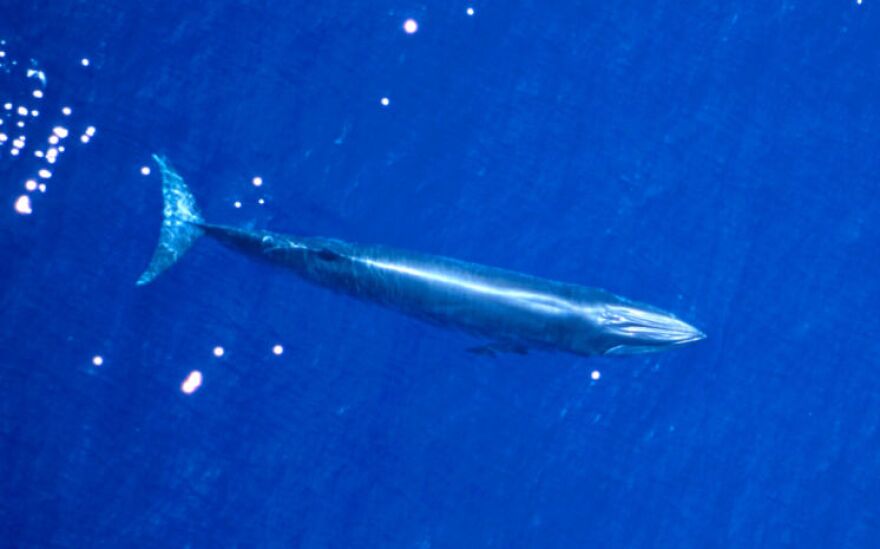One of the rarest and least-known species of whales off of Florida's Gulf Coast could soon be listed as a threatened or endangered species.
Not much is known about the species called the Brydes (pronounced Brewdus) Whale. They live far offshore, with fewer than 100 remaining in an area ranging from roughly Pensacola to the Tampa Bay area. Their prime habitat overlaps with some of the areas hardest hit by the BP oil spill. Estimates show about half of the species were exposed to oil, with 17 percent of the whales killed by the spill. (You can read the Federal Register posting of their findings HERE.)
Laura Engleby is chief of the marine mammal branch of NOAA Fisheries' Southeast Region, in St. Petersburg. She says listing Brydes Whales as endangered could mean giving additional protection to their offshore habitat
"Proposing to list them will hopefully raise awareness, so that people will know that these unique whales are out in the Gulf," she says, "and that there are very few of them and that certainly we're on the path to maybe find out ways to protect them."
The public can comment on the proposal until February 6th. A public hearing will be held in St. Petersburg January 19th. It will be held from 6:00 to 8:00 p.m. at NOAA Fisheries, Southeast Regional Office, Dolphin Conference Room, 236 13th Avenue, South, St. Petersburg.
Here's a section of the report from the Federal Register:
Extinction Risk AnalysisThe SRT (status review team) considered the information provided in the Status Review report and demographic risk factors to conduct an Extinction Risk Analysis (ERA). The SRT summarized its ERA for the GOMx Bryde's whale, placing it in the context of our agency guidelines on how to synthesize extinction risk (NMFS 2015). Those agency guidelines define the high extinction risk category as: A species or DPS with a high risk of extinction is at or near a level of abundance, productivity, spatial structure, and/or diversity that places its continued persistence in question. The demographics of a species or DPS at such a high level of risk may be highly uncertain and strongly influenced by stochastic or depensatory processes. Similarly, a species or DPS may be at high risk of extinction if it faces clear and present threats (e.g., confinement to a small geographic area; imminent destruction, modification, or curtailment of its habitat; or disease epidemic) that are likely to create present and substantial demographic risks. Applying this standard, the SRT unanimously agreed that the GOMx Bryde's whale has a high risk of extinction. The SRT provided the following summary of the concerns leading to its overall extinction risk assessment: The GOMx Bryde's whale population is very small and is restricted to a small habitat area in the De Soto Canyon region of the northeastern [Gulf of Mexico]. Their level of genetic divergence from other Bryde's whales worldwide indicates they are reproductively isolated and on a unique evolutionary trajectory. The Society for Marine Mammalogy's Committee on Taxonomy concluded they represent at least an unnamed subspecies of Bryde's whales. Although the historic population size is unknown, whaling data indicate their distribution in the [Gulf of Mexico] was once much broader. The Team concluded, therefore, based on the best available scientific data, that there has been a range contraction such that their primary range is restricted to the northeastern [Gulf of Mexico] although there are limited data from outside U.S. waters. The north-central and western [Gulf of Mexico] contains some of the most industrialized marine waters in the U.S. due to expansive energy exploration and production, and also experiences significant commercial shipping traffic and commercial fishing activity. The area in the northeastern [Gulf of Mexico], where all verified sightings of Bryde's whales have been recorded during cetacean surveys, has experienced the least amount of energy exploration, due in part to a moratorium put in place in 2006. However, this moratorium expires in 2022 and the eastern [Gulf of Mexico] could be exposed to increased energy activities. Commercial fishing and vessel traffic also could affect the whales in the eastern [Gulf of Mexico]. The Team concluded that the small population size alone put the GOMx Bryde's whale at high risk of extinction. The small size of this population makes it vulnerable to inbreeding depression, demographic stochasticity, and stochastic and catastrophic events. The combination of small size plus risk factors that may have affected the population in the past and may affect it in the future, further increase the extinction risk. These factors include, in particular, impacts due to energy exploration (e.g., habitat modification, noise from seismic surveys, and shipping) and energy production (e.g., oil spills), and vessel collisions. The Team's concern for this group of whales is further increased by uncertainty regarding the cause(s) of its small population size, its limited distribution, current and future threats, and the long-term viability of the population (Rosel et al., 2016). We consider the SRT's approach to assessing the extinction risk for GOMx Bryde's whale appropriate, consistent with our agency guidance, and based on the best scientific and commercial information available. Based on the key conclusions from the Status Review report, including the ERA (Rosel et al., 2016), we find that the GOMx Bryde's whale is a species, as defined by the ESA, which is in danger of extinction throughout all of its range, as a result of ESA Factors A (the present or threatened destruction, modification or curtailment of a species' habitat or range), D (inadequacy of existing regulatory mechanisms), and E (other natural or manmade factors affecting its continued existence). Accordingly, we find that the species meets the definition of an endangered species.




